
Icon – St. Paul
Many Evangelicals love to read and study St. Paul’s letters and consider Paul the greatest missionary of all time. But few stop to think about which church Paul came from. Many know that he was born in Tarsus, was educated in Jerusalem under Rabbi Gamaliel, and that he spent three years in the Arabian dessert after his encounter with Christ. But many would draw a blank if asked: Where was Apostle Paul’s home church? Fewer yet would think to ask: Is Paul’s home church still around today?
Modern Evangelicalism’s historical amnesia has caused many Evangelicals to neglect or ignore the history and practice of this early Church. It is tragic to see how this unspoken Protestant bias is playing out in our day! Learning from church history can provide a valuable corrective.
We read in the book of Acts:
In the church at Antioch there were prophets and teachers: Barnabas, Simeon called Niger, Lucius of Cyrene, Manaen (who had been brought up with Herod the tetrarch) and Saul. While they were worshiping the Lord and fasting, the Holy Spirit said, “Set apart for me Barnabas and Saul for the work to which I have called them.” So after they had fasted and prayed, they placed their hands on them and sent them off. (Acts 13:1-3, NIV; emphasis added)
The Church in Antioch played a significant role in the book of Acts and in early church history. Christianity had its origins in Jerusalem but very little cross cultural missions was done in the early days. As Luke noted in Acts 11:19 at the time Jews evangelized only their fellow Jews. It was not until Jews from Cyprus and Cyrene began to share the Good News of Christ with non-Jews in the city of Antioch that a major evangelistic breakthrough was made (Acts 11:20-21). Then when Paul and Barnabas were commissioned to do missionary work the Church of Antioch became a sending church – another milestone in world missions.
During Paul’s time Antioch was the third largest city following Rome and Alexandria. The city was also a major administrative and military outpost for the eastern edge of the Roman Empire. Its population was multi ethnic comprising native Syrians, Romans, Greeks, and Jews. Antioch had a sizable Jewish presence, of the 300,000 residents about 50,000 were Jews. Rodney Stark in The Rise of Christianity (1997) gives a grim description of what urban living in Antioch must have been like in ancient times. In addition to the overall squalor due to the lack of modern sewers and sanitation, social interaction was marked by ethnic divisions (there were at least 18 different ethnic groups at the time) and numerous newcomers “deficient in interpersonal attachments” (pp. 156-158). Christianity brought hope to many with the promise of new life in Jesus Christ and a new basis for social solidarity in the Church (pp. 161-162).
In terms of religion Antioch was an interesting amalgam. In addition to the pagan religions and Judaism, there was also a certain amount of syncretism taking place. Some of the Jews were drawn to the freedom of Hellenism, while a number of Gentiles were drawn to Jewish monotheism. Many became God fearers, Gentiles who accepted Jewish monotheistic faith but refrained from full conversion to Judaism. Paul’s message that one could become right with God apart from the Jewish Law would appeal to many causing them to become Christians.
Paul Barnett in Jesus & the Rise of Early Christianity (1999) notes that Christianity came to Antioch in two waves. The first wave stemming from the persecution of the church in Jerusalem likely took place in AD 34 – a year after the death and resurrection of Jesus Christ. The second wave stemming from men from Cyprus and Cyrene evangelizing non-Jews likely took place in the late thirties – nearly a decade after Christ’s death and resurrection. This points to rapid growth and expansion of early Christianity. Barnett is of the opinion that the majority of the converts came not from the Jews or the pagans, but from the God fearers.
They were Called “Christians”
Luke’s observation: “The disciples were called Christians first in Antioch” (Acts 11:26) indicates that the number of converts had grown to the point where it had the attention of the general public. The term Christianoi reflected the practice of naming followers of a noted ruler, e.g., Herodianoi and Augustiani. The context for Isaiah’s prophecy in 56:5 points to God’s missionary outreach to the Gentiles and the ingathering of the Jews along with that of the non-Jews. Acts 11:26 can also be viewed as the fulfillment of Isaiah’s prediction of a new covenant and a new name for God’s elect in the Messianic Age.
I will give them an everlasting name that will not be cut off. (Isaiah 56:5)
And,
. . . you will be called by a new name that the mouth of the Lord will bestow. (Isaiah 62:2)
The bestowal of a new name is significant. When Jesus gave Simon the fisherman the name “Peter,” this signaled a new life and a new vocation. Similarly, the emergence of the name “Christian” can be understood as signaling the emergence of a faith community which would take the place of the old Israel and the dawn of a new dispensation of grace.
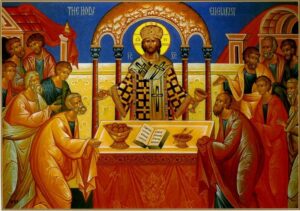
Holy Communion
What is striking about Acts 13:1-3 is how central and important worship is for world missions. Paul received his missionary call in the context of worship. To be precise, Paul received his missionary call during the Liturgy! The original Greek in Acts 13:2 is λειτουργωντων (leitourgounton) which can be translated: “as they performed the liturgy” (Orthodox Study Bible commentary notes for 13:2). As an Evangelical I have heard many missions sermons but not one linking missions to the Sacraments or the Eucharist as the basis for Christian missions!

Middle Wall of Partition Separating Jews from Non-Jews Source
The Church of Antioch is a fulfillment of Isaiah’s prophecy of “a house of prayer for all nations.” (Isaiah 56:7) The sizable influx of Gentile converts described in Acts 11:20-21 changed the church demographics significantly, from predominantly Jewish to predominantly Gentile. There were so many new converts that Barnabas recruited Paul to assist him in the catechizing of the Gentile converts (Acts 11:25-26). Where before Gentiles were separated by a dividing wall in the Jerusalem temple, in the Church Gentiles prayed and worshiped alongside with Jews in the Liturgy. What is happening here in Antioch is historically unprecedented! Here in the Eucharist Christ the Passover sacrifice reconciled Jews and Gentiles with God the Father giving rise to a new Israel! No wall separated them now. Rather, in united fellowship Jews together with their Gentile brothers and sisters partook of the most holy Body and Blood of Christ! Memory of this powerful worship experience in Antioch probably inspired Paul as he wrote in Ephesians 2:11-22 of Christ abolishing the dividing wall in his flesh (v. 15) and making “one new man out of the two”’(v. 15).
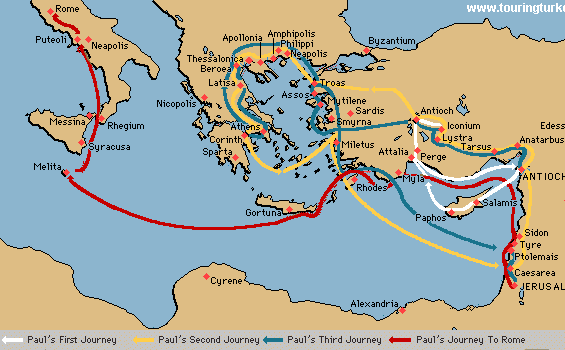
Paul’s Missionary Journeys Source
While Paul’s apostolic ministry was translocal in scope, he was very much rooted in the life of the Church and its sacramental ministry. Acts 13 and 14 describe Paul’s first missionary journey. We read in Acts 13:3: “they placed their hands on them (Barnabas and Paul) and sent them off.” Later we read in Acts 14:26-28 that at the end of the first mission Paul and Barnabas returned to Antioch and reported to their home base on their ministry. A similar pattern can be seen in Paul’s second mission. Paul started out from Antioch, his home base (Acts 15:35-36), and returned to the church at Antioch at the conclusion of the mission (Acts 18:22-23). The strong role of the church in Acts stands in contrast to modern Evangelicalism where parachurch ministries quite often overshadow the local church.
Antioch in Church History

Ignatius – 3rd bishop of Antioch
Just as Antioch played a major role in the book of Acts it would likewise play a major role in church history. Ignatius of Antioch was an early bishop and one of the Apostolic Fathers, i.e., Christians who knew the Apostles personally. Prior to his death circa AD 98/117 Ignatius wrote a series of letters that shed light on what the early Christians believed. In his Letter to the Philadelphians Ignatius wrote:
Take heed, then, to have but one Eucharist. For there is one flesh of our Lord Jesus Christ, and one cup to [show forth] the unity of His blood; one altar; as there is one bishop, along with the presbytery and deacons, my fellow-servants: that so, whatsoever you do, you may do it according to [the will of] God. (Philadelphians 4.1; emphasis added)
Ignatius’ high view of the Eucharist stands in contrast to popular Evangelicalism’s low view of the Lord’s Supper as purely symbolic. Just as striking is Ignatius’ high view of the office of the bishop. Where many Evangelicals hold to a congregationalist ecclesiology or Reformed Christians prefer a presbyterian polity, Ignatius held to an episcopal view of the Church! This is not a momentary quirk but an integral part of his theology. We find in Ignatius’ Letter to the Smyrnaeans:
See that you all follow the bishop, even as Jesus Christ does the Father, and the presbytery as you would the apostles; and reverence the deacons, as being the institution of God. Let no man do anything connected with the Church without the bishop. Let that be deemed a proper Eucharist, which is [administered] either by the bishop, or by one to whom he has entrusted it. Wherever the bishop shall appear, there let the multitude [of the people] also be; even as, wherever Jesus Christ is, there is the Catholic Church. It is not lawful without the bishop either to baptize or to celebrate a love-feast; but whatsoever he shall approve of, that is also pleasing to God, so that everything that is done may be secure and valid. (Smyrnaeans 8:1-2; emphasis added)
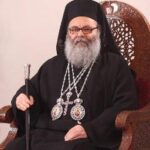
John X – 171st Bishop of Antioch
These passages shed valuable light on Acts 13:1-3. They underscore the importance of the Eucharist in the life of the early Christian Church. Furthermore, they show that the Church in Antioch during Paul’s time was under the rule of a bishop. According to Orthodox Tradition, St. Peter was the first bishop of Antioch. He was then succeeded by Euodius who was followed by Ignatius (cf. Eusebius’ Church History 3.22). The current Patriarch of Antioch, John X, can trace his apostolic succession back to St. Peter as well as to St. Ignatius. According to the list of patriarchs John X is the 171st bishop since St. Peter.
For two millennia the Church of Antioch would guard the Faith and evangelize the nations. The renowned preacher John Chrysostom (Golden Mouth) was born and raised in Antioch. He later edited the Liturgy of St. John Chrysostom which is still in use today. The church was also known as the home of Antiochene Theology which emphasized a more literal and historical reading of Scripture than the allegorical method favored in Alexandria. With respect to Christology the Antiochene School insisted on Christ’s true humanity.

Patriarchate of Antioch, Damascus, Syria Source
The city of Antioch has not been sheltered from the upheavals of history. Shifts in trade routes, numerous Crusades, and the Mongol invasion resulted in the city’s decline and the removal of the ancient Patriarchate in the 1200s to present day Damascus. Today it is known as Antakya in present day Syria.
The Antiochian presence was established in the US during 1800s when political events and economic conditions forced many in the Middle East, especially Syria, to emigrate. An account of the challenges the young immigrant community faced in America can be found in Peter Gillquist’s Metropolitan Philip: His Life and His Dreams (1991). The Antiochian Archdiocese was instrumental in receiving some 2000 Evangelicals into the Orthodox Church. To become Orthodox these Evangelicals needed to adopt the faith and worship of the Antiochian Patriarchate. The welcoming of the Evangelicals in 1987 has done much to dispel the notion that Orthodoxy is an ethnic church constrained by ties to language and customs of the old world. One thing I have noticed in my visits to Antiochian Orthodox churches is that while their parishes tend to reflect mainstream American culture their doctrine and worship are identical to other Orthodox churches whether Greek, Russian, Serbian, Ukrainian, etc.
Antioch’s Challenge to Protestants
If the Church of Antioch is Apostle Paul’s home church and if it still exists today then Evangelicals and Protestants are faced with some challenging questions. Is my church like the Church of Antioch? Do the doctrines and practices of my church resemble that of Antioch?
The Church in Antioch as described in Acts 13:1-3 and Ignatius’ letters provides three markers of early Christianity: (1) it was liturgical, (2) it practiced fasting, and (3) it was episcopal in structure. Inquiring Protestants and Evangelicals can use these three markers (among others) as a means of evaluating their church tradition.
Evangelicalism’s historical amnesia has created a huge blind spot in their theology. One of the basic assumptions of Protestantism is that the early Church fell into heresy soon after the first generation of Apostles passed away but when one looks at history one can find no evidence of such apostasy. The absence of apostasy points to a fundamental continuity in the Church of Antioch. Antiochian Orthodox parishes today like Acts 13:1-3 use liturgical worship and fast on a regular basis. As a matter of fact, liturgy and fasting are very much a part of Orthodox Christianity everywhere. And like Ignatius’ letters all Antiochian Orthodox parishes live under the authority of a bishop whose apostolic lineage goes back to Acts 13.
The Protestant Reformation resulted in a number of developments that diverged from Acts 13:1-3. The doctrine of sola scriptura (Scripture alone) has resulted in the sermon displacing the Eucharist as the focal point of Sunday worship. Under the influence of Puritanism worship was simplified to the point where the Lord’s Supper became a mere symbol. Fasting which was an important spiritual discipline to both Judaism and historic Christianity is for all purposes absent in Evangelicalism. The Reformed tradition has been inconsistent and erratic in its approach to fasting, and more recently, at times hostile.
Come and See!
Evangelicals and Protestants have the opportunity to go beyond reading Paul’s letters by visiting a local church that has a direct historical link to Paul’s home church, the Church of Antioch. Today there are over 250 Antiochian Orthodox parishes in the US, many within driving distance. The curious inquirer may find reading Orthodox books and blogs very helpful for understanding Orthodoxy, but there is no substitute for an actual visit to an Orthodox worship service. There you will experience firsthand the hymns, prayers, incense, and ritual of the Divine Liturgy (usually of St. John Chrysostom originally of Antioch!). A visit to an Orthodox Liturgy offers an Evangelical or Protestant a unique and holy opportunity to reconnect with the ancient roots of the Christian Faith.
Go and visit! And let us know what you think of the ancient Liturgy.
Robert Arakaki
“A Peek Into Orthodoxy” — a video preview of a visit to an Orthodox Church

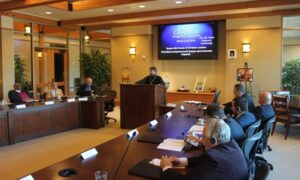
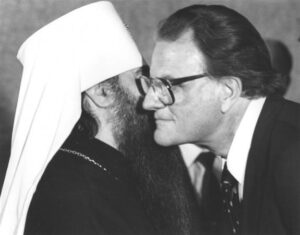
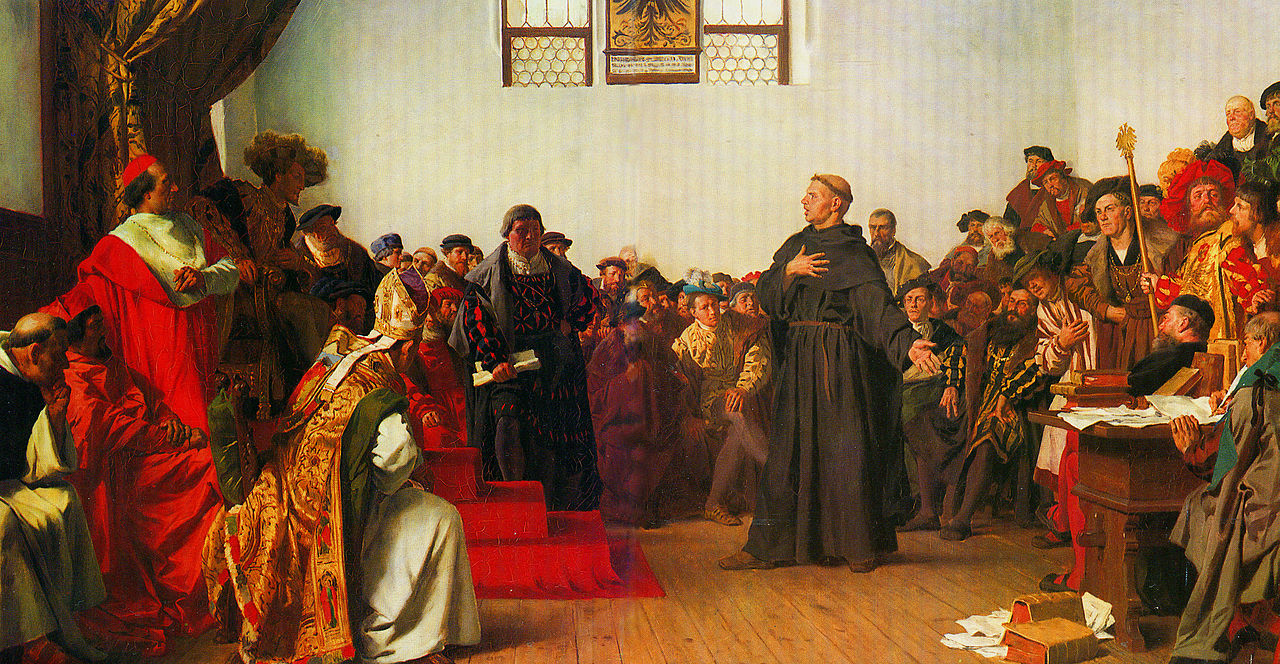









Recent Comments